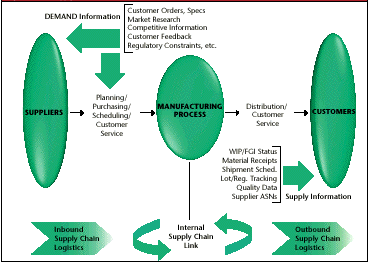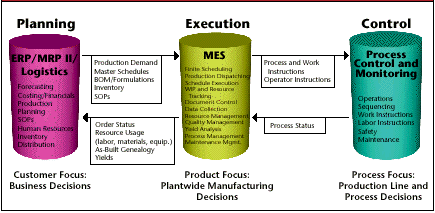|
The plant manager of an electronics manufacturer was pressing the third-shift production supervisor for some hard-and-fast answers. He needed to know why the last three runs off the back end of line 4 failed quality tests and had to be put back into the rework loop.
With this hot order on hand, suppositions wouldn't do. There were too many factors involved: Process problems related to equipment performance, uncalibrated instrumentation or a new supplier of a particular component in that particular lot were all possible causes.
A year ago, the plant manager would have faced serious productivity problems if he'd shut down the line to try to identify the problem. But with the plant's new manufacturing execution system (MES), which had been integrated into the supply chain management system, answers could be found in time to minimize downtime and scrapped product. By using relational databases to store and associate process and product data, which then could be compared against any single production order, the MES provided management with the information needed to quickly determine the exact cause of the problem on line 4.
Using information gathered by the MES, management traced the problem to a different component from a new supplier and immediately took corrective action. Purchasing tightened incoming supplier quality control and returned to the previous component. The problem was solved.
For our electronics manufacturer, the MES was the vital internal link of the supply chain, providing an automated feed between upper-level enterprise resource planning (ERP) and manufacturing resource planning (MRP II) systems and the plant floor control systems, coordinating both inbound and outbound supply chain logistics of manufacturing.
By automating the planning-execution-control loop while synchronizing and integrating all of the resources, methods, procedures and tools used to accomplish production, the MES provides the ultimate foundation for a plantwide continuous improvement program capable of achieving true Six Sigma manufacturing.
What is MES?
AMR Research, a Boston-based industry and market analysis firm, defines an MES (also known as a supply chain execution system or enterprise production system) as a functional layer of information technology that links business planning and shop floor control systems to deliver to manufacturing an achievable and realistic production plan.
According to Manufacturing Execution Systems Association International, a nonprofit association in Pittsburgh representing MES software vendors: "Manufacturing execution systems deliver information that enables the optimization of production activities from order launch to finished goods. Using current and accurate data, MES guides, initiates, responds to and reports on plant activities as they occur. The resulting rapid response to changing conditions, coupled with a focus on reducing nonvalue-added activities, drives effective plant operations and processes. MES provides mission-critical information about production activities across the enterprise and supply chain via bidirectional communications."
Where does MES fit in?
In today's intensely competitive markets, the manufacturer's mission is to do more with less, and do it faster, better and cheaper. To accomplish this, manufacturers need real-time information management tools for continuous improvement and decision support. Timely and accurate information is the key to the successful application of ISO 9000, business process reengineering, theory of constraints and lean/agile manufacturing initiatives. Such programs aim to achieve competitive advantage by collecting, analyzing and correlating data to determine root causes of process bottlenecks and inefficiencies. The latest information technology is required in today's complex business environment of high-speed continuous change because it enables business agility by accommodating unforeseen changes and automating the information flow. An MES provides an automated vehicle for continuous improvement, empowering the quality process to new levels.
The proper use of accurate data in measuring, analyzing, improving and controlling performance forms the foundation of classic Six Sigma methodology. Today's complex and dynamic business environment also requires the use of online integrated information technology, specifically the MES. Such technology automates the data-collection and information flow, turning Six Sigma concepts and practices into decision support tools directly tied to the overall goals and objectives of the business.
MES and continuous shop floor improvement
The most recent concept from the consulting community to improve productivity and achieve zero-latency manufacturing is supply chain management. Unfortunately, the fact usually overlooked in supply chain management discussions is that the manufacturing systems provide one of the most critical points of that supply chain (see Figure 1).
Figure 1: The Supply Chain
 |
A manufacturing company is primarily concerned with three major links of the supply chain. The first link is inbound logistics, which includes all functions upstream from actual manufacturing and is focused on sourcing and preparing for manufacture. The second link is the manufacturing function itself, which is focused on facilities, equipment, labor, material and the process. The third link is outbound logistics, which is focused on finished goods and distribution. Although the inbound and outbound logistics links tend to be very customer- and order information-centric, requiring a great deal of information about customers, suppliers, orders and shipments, the manufacturing link tends to be very process- and production-centric. Whereas it has traditionally been easier to adapt and integrate information systems associated with the inbound and outbound logistics activities due to their alignment with ERP system functionality, it has been more difficult to adapt and integrate the manufacturing component because of its dynamic nature and uniqueness from plant to plant.
Supply chain management applications, advanced planning and especially finite capacity scheduling software all require accurate data from the activities on the shop floor to be effective. The shop floor is a very dynamic, constantly changing environment, and the likelihood of order status, cycle times, scrap and downtime information, setup and changeover times, and resource and capacity data being accurate and up-to-date is low if that information isn't automatically being collected. The focus of manufacturing operations is to attain better yields, shorter cycle times and increased quality while being capable of handling dynamic demand fluctuation. However, improvements in these areas traditionally haven't been linked back to the planning system, resulting in a disconnection between plans and reality. An MES provides visibility to manufacturing data and closes the internal supply chain link. This facilitates more accurate and timely optimization by the planning and scheduling systems.
Appropriate application of MES tools is also necessary to enable companies to maximize return on their ERP/supply chain management/advanced planning and scheduling investment by providing accurate, timely data and closing the loop between plans and actions (see Figure 2). Imagine spending millions of dollars on a fighter jet but forgetting to put in any instruments for determining speed, altitude, location or fuel level. Doing that is much like spending tens of millions of dollars on an ERP or supply chain management implementation, only to leave it starved for information needed from the MES layer.
Figure 2: Enterprise Information Flow
 |
MES and regulatory data collection
Another powerful result of the appropriate application of MES technology is the ability to satisfy data collection and record-keeping requirements with little or no additional expenditures. Data collection, in addition to serving as the foundation of quality management and continuous improvement programs, is often required to satisfy regulatory demands (such as those for product history or environmental data) or to meet customer requirements (such as QS-9000 or certificates of compliance).An MES provides the real-time visibility of all plant data so that scheduling and planning software can optimize it. MES tools provide a meaningful relationship between business data and factory data. Communication between control equipment and personnel via device servers and customized graphical user interfaces provides a decision-making foundation that permits users or operators to concentrate on solving their operational issues and problems. An MES provides real-time decision-making support to production and quality management, synchronizing all of the resources and activities on the shop floor.
The appropriate application of information technology offers a number of quantifiable business benefits by optimizing the manufacturing process, increasing the process' responsiveness and flexibility, and reducing the cost of information. Effective MES implementations have been shown to provide dramatic return on investment. Equally important, they provide an infrastructure designed to accommodate change, be it externally induced (as by new regulations, changes in the market or customer demands), internally driven (as by corporate improvement initiatives, ongoing cost control efforts or process redesign) or technology-driven (as by new systems or new platforms).
The real key to an MES is that the system automatically interfaces the shop floor control layer, which is manufacturing the actual product. Thus it is the ideal vehicle to automatically collect any data needed for or by any other information system in the organization, including quality; document management; maintenance management; materials management; and time, attendance and labor management. An MES provides a plant-resident, real-time total production database that correlates process data, product data and order data. This provides for total product traceability while providing a continuous improvement platform for plant operations. An MES allows users to quickly answer questions related to quality, scrap, downtime or yields and to see the cause-and-effect relationships of product, process and materials.
Benefits of a properly designed and installed MES
Prior to the advent of the MES, information technology tools were incapable of providing the real-time data that production managers require to make accurate, informed decisions. MES software can supply this information by performing the following critical functions:
![]() Mapping customer orders to specific production runs
Mapping customer orders to specific production runs
![]() Controlling and dispatching orders
Controlling and dispatching orders
![]() Updating the scheduler with actuals (e.g., labor, material and machines)
Updating the scheduler with actuals (e.g., labor, material and machines)
![]() Defining and enforcing production procedures and business rules
Defining and enforcing production procedures and business rules
![]() Automatically alerting production personnel to deviations from production rules
Automatically alerting production personnel to deviations from production rules
![]() Dispatching and coordinating material and required information for unit operations
Dispatching and coordinating material and required information for unit operations
![]() Real-time production reporting (e.g., materials usage and scrap)
Real-time production reporting (e.g., materials usage and scrap)
![]() Integrating SPC/SQC (quality management)
Integrating SPC/SQC (quality management)
![]() Providing real-time feedback and automatic alerts to positively affect the current run
Providing real-time feedback and automatic alerts to positively affect the current run
![]() Defining and enforcing specific equipment, routes, operator and material combinations for a particular work order or product
Defining and enforcing specific equipment, routes, operator and material combinations for a particular work order or product
When manufacturing companies establish flexible, responsive information infrastructures that rapidly respond to changes in product, process, people and procedures, such as those provided by MES, they attain the necessary agility required to compete in today's business climate. The final result is product superiority, increased yields, reduced cycle times and production costs, and accelerated responsiveness to customer needs and market demands--also known as competitive advantage.
About the author
Jonathan Kall is founder and president of Interwave Technology Inc., a manufacturing information technology consulting, advanced systems integration and software development firm that designs and implements enterprisewide manufacturing automation, execution and information systems. He has more than 18 years' experience in management, engineering and marketing of industrial computer control and real-time information systems. Kall can be reached via e-mail at jkall@qualitydigest.com .
Next month, part two of this article will focus specifically on how an MES addresses the quality function, including discussion of how it can automatically satisfy ISO 9000 requirements. Part two will also present an MES case study.